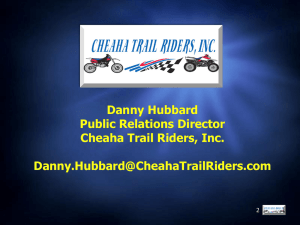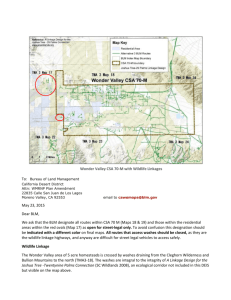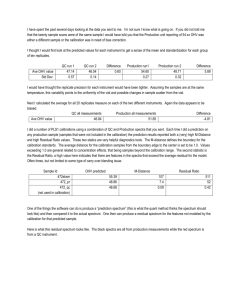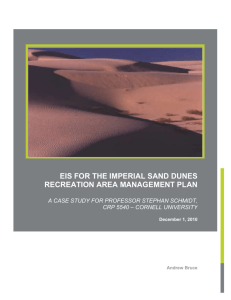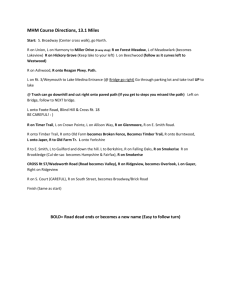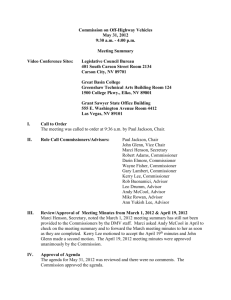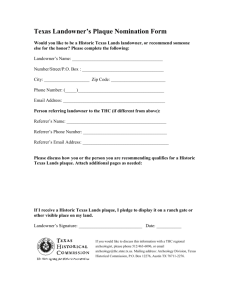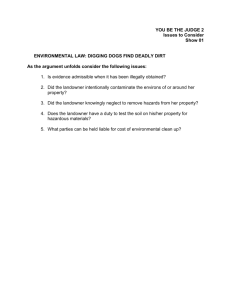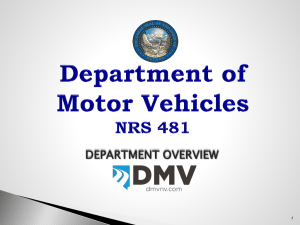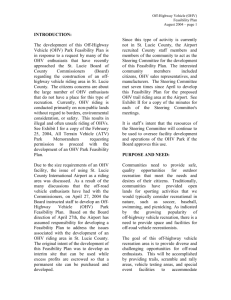- National Off-Highway Vehicle Conservation Council
advertisement
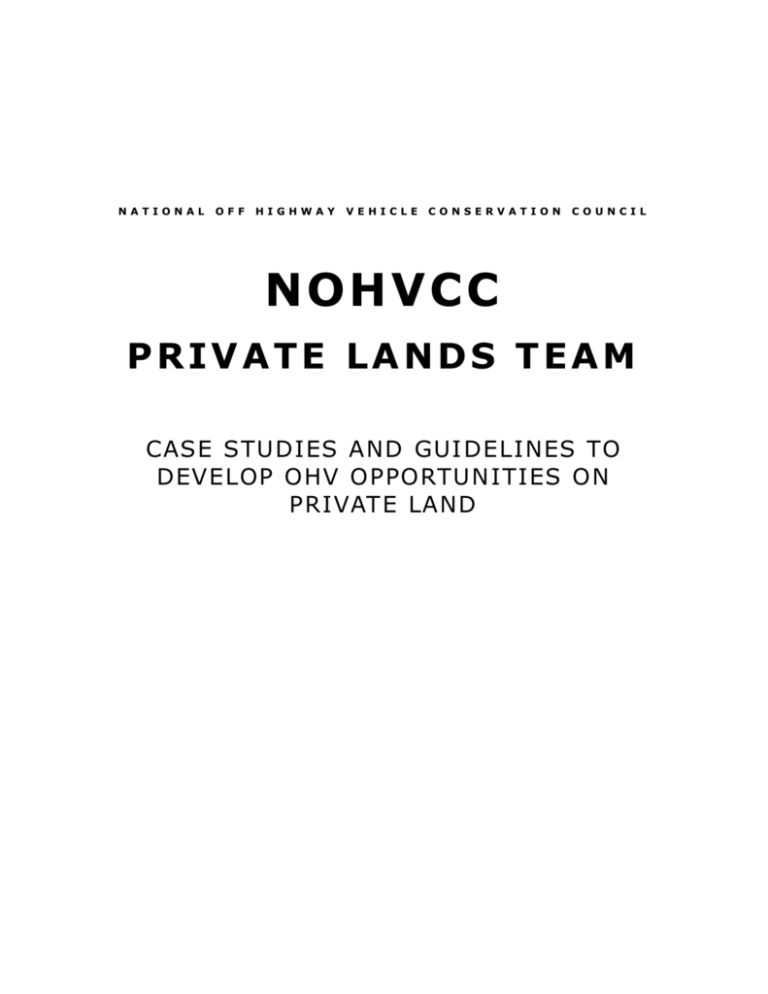
NATIONAL OFF HIGHWAY VEHICLE CONSERVATION COUNCIL NOHVCC PRIVATE LANDS TEAM CASE STUDIES AND GUI DELINES TO DEVELOP OHV OPPORTUN ITIES ON PRIVATE LAND INTRODUCTION DEVELOPING OHV OPPOR TUNITIES ON PRIVATE L AND PRIVATE LANDS TEAM - OUR VISION AND GOALS Identify and develop all potential opportunities for OHV recreation on private land Develop resources for private landowners to create safe, responsible OHV trails Develop resources for land acquisitions for OHV parks and lease contracts Develop a library of resources and materials related to Private Land issues Develop lists of specific contractors, advisors and consultants that are OHV friendly Develop lists of potential funding sources for public/private OHV park projects Identify existing and potential programs for developing OHV use on private land Private landowner participation in organized trail systems Promoting public/private partnerships Investigate and utilize conservations, easements and trusts Purchasing property with Recreational Trail Program grant funds Working with large private corporate landholders (mining, timber, etc) Promoting OHV Parks as drivers of economic development Identify potential of brownfields as OHV opportunities Major Challenges Understanding and assisting landowner concerns regarding Insurance/Liability Different state laws with respect to landowner liability limits and costs Act on landowner issues in a reasonable time frame and mitigate identified issues Establish and maintain credibility, reputation and accountability Identify value added to landowners for allowing OHV recreation 2 HOW TO USE THE CASE STUDY INFO PROVIDED IN THIS REPORT The Public Lands Team has gathered reports from NOHVCC State Representatives and edited their feedback to provide these case studies in a reasonably consistent format. We have tried to provide any alternative perspectives, that are sometimes neglected, to help our readers understand and learn how better communication, planning, and execution can make or break a project. Some examples of issues and actions may be limited in scope and detail, simply due to the conditions in that state or based on that particular situation. 1) The Participants - What were the wants and needs according to both sides involved in the local area - the trail riders/club members versus the landowners or political subdivision? During the initial stages of determining feasibility and project planning, how did the various participants anticipate or speculate the process would work? 2) The Issues On The Table - Success is determined by how we manage to work through and move past what gets in our way. What were the Positive Issues and Negative Issues? Without injecting personal bias or exaggeration, what were the real-world feelings behind these issues? How did the various participants accept or reject the various project ideas? 3) The Decision - Offer an easy to learn and remember moral to the story. Briefly explain short term and long term positive and negative agreement and disagreement, compromises, decisions, etc between the project participants. If possible, offer a brief step-by-step timeline for how the proposal or project has developed - or will develop or not develop based on current conditions and anticipated future conditions. OPTIMISM AND P ERSISTENCE - MAKE PROGRESS POSSIB LE In the course of working on these case studies, we have rediscovered that maintaining an optimistic attitude in the face of setbacks, and being stubbornly persistent, really are the keys to success. Renewing lost optimism in volunteers is the most critical job of leadership. Occasionally we see projects enjoy unexpected good luck and great leaps of progress, but in between those great leaps, most of the real progress on the ground is made in small baby steps by volunteers who are already emotionally prepared for the time and effort it takes for a grand project idea to develop. Teaching volunteers this skill should be a priority. Experienced club officers and rider organizers understand how volunteerism efforts often swing with momentum from great enthusiasm to frustration and apathy. Progress is often painfully slow to accumulate into something tangible we can take to our volunteer base and show them that their individual efforts collectively do indeed make a huge difference. The great lesson to be learned from this report is to recognize what often are overlooked as seemingly random, insignificant, small opportunities to make forward progress possible. It is in those baby step opportunities that great volunteerism often does it's best work. 3 SURVIVAL OF AN URBAN LAKEFRONT OHV PARK -- TEXAS The City of Trophy Club is an affluent political subdivision on Lake Grapevine within the busy Dallas/Ft.Worth metro area. For many years, part of the Trophy Club parks system has included a relatively small (+/- 800 acre) property owned by the Army Corp of Engineers. The park is open to the public and primarily used by three groups - as a parking and access point by local fishing enthusiasts to reach the lakefront - as parking and trailhead for equestrians who use it as part of a substantial trail system that skirts the shores of Lake Grapevine - and +/- 300 acres are dedicated for use as a motorized vehicle recreation area. The OHV Park charged a small gate fee to riders that produced some limited income for the City to pay one gate staff and utilities, but not enough to cover improvements. The annual flooding damage and lack of adequate trail management in such a small acreage area had lead to out of control user created trails and muddy unpaved trailhead areas. THE PROJECT - SAVE THE OHV PARK FR OM CLOSURE 1) The Participants The political subdivision was told by the ACOE to deal with the issues or close the park, but they realized the OHV traffic provided enough income to be financially self sufficient - and if traffic into the park improved, possibly profitable. Keeping the park open eliminated the trespassing issues common in Texas, so there was a need by the public for this riding area. 2) The Issues On The Table The City saw a potential financial benefit to improving the park, but had no budget for this sort of project. Their priority to the local taxpayer/homeowner was schools and streets, not providing riding areas for DFW area enthusiasts. The ACOE was willing to allow the City to continue to lease and operate the OHV area, but with better management/improvements. Neither the City or the ACOE had funds to invest - and no local riders/clubs were volunteering to step up and take on the challenge. The local riders thought the park maintenance had been neglected too many years and their suggestions for improvements were never given adequate recognition, so apathy ran high. The majority had no sense of the importance of keeping the park open and had little interest in volunteering to help. 3) The Decision A few activists on the state level realized that by having this park already operating for many years, and a City/ACOE partnership willing to keep it open, they had to act now. They contacted the NOHVCC Rep, who worked with the City Parks Manager to develop a plan of action. The City Manager got the proposal passed by City Engineering and City Council. The NOHVCC Rep wrote a RTP grant for the OHV Park improvements and the grant was awarded by TPWD. The City Parks Dept began a three year plan to shut down most of old user-made trails, rehabilitate the proposed trail system, build a new paved parking/trailhead areas for motorized users and a new parking/trailhead for equestrian users, and rehab the old restroom facility that had not been functional for several years. 4 TIMBER COMPANIES / HUNTING LEASES / OHV RIDING -- TEXAS A large Timber Resources Company in Texas was considering options for producing income on land near developing rural/urban areas. Historically, timber companies in Texas depend on the annual income generated by leasing their land to private deer hunting clubs, or to the Texas Parks and Wildlife Dept (TPWD) hunting lease program. As more land is being depleted of their income potential due to urban sprawl and loss of hunting, the recreational income divisions of some timber companies are seeking other options. THE PROJECT - DEVELOP OHV TRAILS O N TIMBER CO. LAND 1) The Participants The Timber Company Recreational Income Division contacted the Texas NOHVCC Rep to inquire about the prospect of local or state OHV organizations leasing timber land on one semi-rural property north of the Houston metro area for OHV trail development. The NOHVCC Rep contacted local and state OHV Orgs to find a partner for developing this OHV Park idea, but no organization was willing or able to take on this project, so the plan was proposed to develop an OHV Park using proven TMTC and Texas ACOE Rules/Guidelines and to create a non-profit 501c3 entity specifically to service this project. 2) The Issues On The Table The Timber Co already had trespassing issues on land left vacant and unmonitored for long periods of time - mostly with locals riding ATVs and the building of camps for illegal hunting. Managed OHV use meant active trail users would help ease current land manager time and effort and help eliminate some need for local or company law enforcement. The two key problems for the OHV side of the table were the proposed monthly cost of the lease and the rights of the landowner to cancel the lease agreement at any time. Income produced by hunting in Texas is substantial, so the Timber Co anticipated their seasonal income could be supplemented with a more year-round income. The landowner was asking for typical hunting club lease rates on a per-month basis. Even with substantial gate fees to cover staff, utilities, lease obligations, there would be no income left for improvements or to cover the 20% match for RTP grants. But, from a "build it and they will come" perspective, the financial obligations could be addressed and handled. 3) The Decision This project could not guarantee the required landowner commitment, so no agreement could be reached. The landowner required that once trail systems are developed, the company forest resource management staff would evaluate annually to determine if resources are at risk - and if so, the trail systems and/or OHV Park would be shut down. This OHV Park would require TPWD to award one or more substantial RTP grants to provide trail building equipment, develop trail systems and build out the park infrastructure. When using public funds, we have an obligation to insure we are producing long term benefit to the taxpayer, so a commitment by all parties for at least 10-15 year would be required. 5 SIECKE STATE FOREST - UNMANAGED TRAILS -- TEXAS Traditionally, Texas Forest Service land is not open to OHV use, but one inventive and open-minded State Forester realized that the best way to eliminate the constant illegal ATV trail use and building of user made trails in his State Forest is not to spend every effort trying to keep them out and chasing them down all the time - but instead to develop a managed OHV trail system, with a gated entrance and designated trailhead areas. THE PROJECT - CREATE A MANAGED TRAIL SYST EM 1) The Participants This Siecke State Forest is not extremely large (1722 acres) but has roads on all sides that allow easy access points through unmonitored fence lines, so over the past few years, dealing with illegal ATV and dirtbike riding has been increasing as OHV popularity increased. Working with the Texas Parks and Wildlife Dept (TPWD) OHV Program, and the local S.E. Texas Off Road Riders (SETORR), the State Forest is has actively searched for user group support and held meetings with the state OHV program and local OHV orgs to develop a trail management plan that insures long term commitment and success. 2) The Issues On The Table The issues were not the usual Texas private land access issues, but instead, how best for the State Forester to redirect and manage existing OHV use away from areas of concern for resource protection. The Forester had identified areas where he could develop trails systems that would help eliminate the pressure on sensitive areas - and had well thought out ideas for how to manage traffic into and around his State Forest, direct traffic to future trailheads, develop trail patrols to help trail users self manage, etc. The primary issue the State Forester has to deal with is zero budget, personnel, or resources dedicated to the Forest. All the work the Forester wants to do requires federal or state grants working strictly through organized volunteer efforts. The Texas Forest Service historically has no recreation agenda. They plant trees and cut trees. But by contrast, they also do not have alot of the red-tape that the USFS in Texas has to deal with. 3) The Decision The State Forester came into the meetings with TPWD and local clubs fully prepared. He had detailed maps of his State Forest, soil condition maps, species distribution maps, etc. and was already prepared to use advise from OHV experts and volunteers on how best to turn around the situation and manage it. From a OHV activist and enthusiast perspective, finding volunteers to support this project was easy. Based on the details and research provided by the Forester, it was easy for the Texas NOHVCC Rep to help draft a RTP grant, that the TPWD OHV Program awarded. This project is ongoing and should prove to be a great success. 6 XXX XXX XXX -- TEXAS The xxx xxx xxxxxxxxxxxxxxxxxxxxxxxxxxxxx xxxxxxxxxxxxxxxx xxxxxxxxxxxxx xxxxxxxxxx xxxxxxxxxxxxxxxxxxxxxxxxxxxxx xxxxxxxxxxxxxxxxxxx xxxxxxxxx xxxxxxxx xxxxxxxxxxxxxxxxxxxxxxxxx xxxxxxxxxxxxxxxxx xxxxxxxxxxxxxxxxxxxxxx xxxxx. Xxxx xxxxxxxxxxxx xxxxxxxxxxxxxxxxxxxxxx xxxxxxxxxxxxxxxxxxxxx xxxxxxxx xxxx xxxxxxxxxx xxxxxxxxxxxxx xxxxxxxxxxxxxxxxxx xxxxxxxxxxxxxxxxx xxxxxxxxxxxx xxx xxxxx xxxxxxxxxxx xxxxxxxxxxxxxxxxxxxxxxxxxxxxxxxxxxxxxxxxxx xxxxxxxxxxxxxxx xxxxxxxxxxx xxxxxxxxxxxxxxxxxxxxxxxxxxx xxxxxxxxxxxxxxxxxxxxx xxxxxxxxxxxxxx xxxxxxxxxxxx xxxxxxxxxxxxxxxxxxxxxxxxxxxxxxxxxxxx xxxxxxxxxxxxx. Xxxxxxxxxxxxxxxxxxxxxxx xxxxxxxxxxxxxxxxxxxxxxxxxxxxxxxxxxxxx xxxxxxxxxxxx xxxxxxxxxxxxx xxxxxxxxxxxxxxxxxxxxxxxxxx xxxxxxxxxxxxxxxxxxxxxx xxxxxxxx. THE PROJECT - XXXX XXXXXXX XXXX XX XXXX 1) The Participants The xxx xxxxxxxxxxxxxxxxxxxxxxxxxxxxxxxxxxxxxxxxx xxxxxxxxxxxxxxxxxx xxxxxxxx xxxxxxxxxxxxxxxxxxxxxxxx xxxxxxxxxxxxxxxxxxxxxxxxxxxxxxxxxxx xxxxxxxxxxx xxxxxxxxxxxxxxxxxxxx xxxxxxxxxxxxxxxxxxxxxxxxxxxxxxxxxx xxxxxxxxxxxxxxxxx xxxxxxxxxxxxxxxxxxxx xxxxxxxxxxxxxx xxxxxxxxxxxxxxxxxxxxxxxxxxx xxxxxxxxxxxx xxxxxxxxxxxxxxxxxxxxxxxxxxxxxxxxxxxxxxxx xxxxxxxxxxxxxxxxxxxxxxxxxxx. 2) The Issues On The Table The xxxxxxxxx xxxxxxxxxxxxxxxxxxxxxxxxxxxx xxxxxxxxxxxxx xxxxxxxxxxxxxxxxxx xxxxxxxxxxxxxxxxx xxxxxxxxxxxxxxxxxxxxxxxxxxxxxxxxxxxxxxxxxxxxx xxxxxxxx xxxxxxxxxxxxxxxxxxxxxx xxxxxxxxxxxxxxxxxxxxxxxxxxxxx xxxxxxxxxxxxxxxxxxxxxx xxxxxxxxxxxxxxxxxxxxxxxxxxxxxxxxx xxxxxxxxxxxxxxxxxxxxxxxxxxx xxxxxxxxxxxx xxxxxxxxxxxxxxxxxxxxxxxx xxxxxxxxxxxxxxxxxxxxxxxxxxxxx xxxxxxxxxxxx. Xxxxxx xxxxxxxxxxxxxxxxxxxxxxxxxxxxxxxxxxxx xxxxxxxxxxxxxxxxxxxxxxxxx xxxxxx xxxxxxxxxxxxxxxxxxxxxxx xxxxxxxxxxxxxxxxxxxxxxxxxx xxxxxxxxxxxxxxxxxxxxxxx xxxxxxxxxxxxxxxxxxxxxxxxxxxxxxxxxx xxxxxxxxxxxxxxxxxxxxxxxxx xxxxxxxxxxxxxxx xxxxxxxxxxxxxxxxxxxxxxxxxxx xxxxxxxxxxxxxxxxxxxxxxxx xxxxxxxxxxxxxxxxxxxx xxxxxxxxxxx xxxxxxxxxxxxxxxxxxxxxxxxxxxxx xxxxxxxxxxxxxxxxxxxx xxxxxxxx . 3) The Decision And so xxxxxxxxxxxxxxxxxxxxxxxxxx xxxxxxxxxxxxxxxxxxxxxx xxxxxxxx xxxxxxxxxxxx xxxxxxxxxxxxxxxxxx xxxxxxxxxxxxxxxxxxxxxxxxxxxxx xxxxxxxxxxxxxxxxxxxxxxxxx xxxxxxxxxxxxxxxxxxxxxxxxxxxxxxxxxxx xxxxxxxxxxxxxxxxxxxxxxxxxxxxxxxxx xxxxx xxxxxxxxxxxxxxxxxxxxxxxxxxxxx xxxxxxxxxxxxxxxxxxx xxxxxxxxxxxxxxxxxxxxxxxxx xxxxxxxxxxxxxxxxxxxxxxxx xxxxxxxxxxxxxxxxxx xxxxxxxxxxxxxxxxxxxx. Xxxxxx xxxxxxxxxxxxxxxxxxxxxxx xxxxxxxxxxxxxxxxxxxxxxxx xxxxxxxxxxxxxxxxxx xxxxxxxxxxxxxxxxxx xxxxxxxxxxxxxxxxxxxxxxxx xxxxxxxxxxxxxxxxxxxxxxxxxxxxxxxxx xxxxxxxxxxxxxxxxxxxxxx xxxxxxxxxxxxxxxxxxxxxxxxxxxx xxxxxxxxxxxxxxxxxxxxxxx xxxxxxxxxxxxxxxxxxxxxxxxxx xxxxxxxxxxxxx xxxxxx. 7 Appendix -- 04/03/2008 -- Notes from PRIVATE LANDS Team Leader, Mark Mitchell Mission Statement Identify and develop all potential opportunities for OHV recreation on private land Vision Statement - Identify and develop resources for land acquisitions for OHV parks Identify and develop resources for lease contracts Identify and develop resources for private landowners to create safe, responsible OHV opps Develop library of resources and materials related to Private Land issues Develop lists of specific contractors, advisors, consultants that are OHV friendly Develop lists of potential funding sources Develop boiler plate language for all of the above Design set of comprehensive 12 step programs for developing OHV opportunities on private land - Private landowner participation in organized trail systems Public / private partnerships Utilizing conservations, easements and trusts Purchasing property with RTP funds Working with large landholders (mining, timber, etc) OHV Parks as drivers of economic development Identify potential of ‘brownfields” as OHV opportunities Action Items/Timeline May 1, 2008 – ALL team members submit written report on successes and/or challenges in their state, we want details. This information will form the basis for a partner wide survey of private land issues. Primary goal – develop comprehensive list of successes, resources, challenges, contacts in preparation for 2009 conference discussion June 1, 2008 – submit survey to all NOHVCC partners for completion September 1, 2008 – partner surveys competed and returned to team lead, team will then be split into teams to compile, analyze and organize data for comprehensive report January 1, 2009 – draft report ready for review and editing March 2009 – Report completed and delivered at 2009 conference then followed by panel discussion on private land issues Major Challenges - Insurance / Liability Assist and understand landowner concerns with respect to liability Mitigate identified issues Act on landowner issues in a reasonable time frame Establish and maintain credibility, reputation and accountability Investigate use of conservations, easements and trusts Differing state laws with respect to landowner liability limits Identify value adds to landowners for allowing OHV recreation 8
